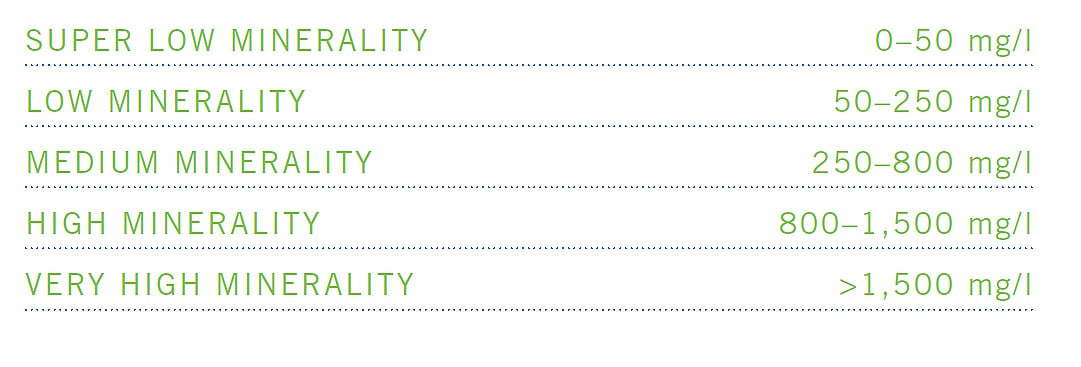Water's subtle taste and terroir are determined by the type and amount of minerals it contains. The type of minerals can be found in the water's analysis of the source. There the amount of minerals dissolved in water is indicated as total dissolved solids, measured in milligrams per liter (mg/l) or parts per million (ppm), which are equal. A water's TDS is usually composed mainly of carbonates, bicarbonates, chlorides, sulfates, phosphates, nitrates, calcium, magnesium, sodium, potassium, iron, manganese, and other minerals. Gases, colloids, and sediment aren't included in the TDS measurement. TDS is the most critical factor giving water its taste and character. The higher the mineral content, the more distinct a water's taste can be. Think of low TDS waters as comparable to white wines, with a clean, neutral taste and less weight. High TDS waters are more like red wines, with a heavier, more substantial feel. Very high TDS waters feel distinctly rich and may have an aftertaste, much like a big, bold red wine.
However, most mineral water you drink probably has a low-tomedium TDS measurement and is more like a heavy white or a light red wine. Regulations regarding TDS vary throughout the world. In the U.S., bottled water must contain at least 250 mg/l TDS to be labeled as mineral water. TDS above 500 mg/l qualifies a water as "low mineral content" while more than 1,500 mg/l allows a "high mineral content" label. Distilled water has a TDS of 0 mg/l; seawater has about 34,000mg/l. Most bottled waters fall within a TDS range of 50 to 800 mg/l (Acqua Panna, 188 mg/l; Fiji, 210 mg/l; Evian, 357 mg/l; Perrier, 475 mg/l), but many well-known waters have a much higher TDS (San Pellegrino, 1,109 mg/l; Badoit, 1,200 mg/l; Contrex, 2,032 mg/l; Gerolsteiner, 2,527 mg/l). Some of these waters are thought to be curatives — their mineral compositions are believed to have healing properties (Famous Crazy, 2,783 mg/l; Vichy Célestins, 3,378 mg/l). There are many glaciers, icebergs, and rain waters in the super low category of waters with a TDS below 50 mg/l. Some waters have an exceptional terroir and super low Minerality, even so, they come from springs or artesian sources.
TDS is a very technical term and does not feel epicurean. That's why I prefer the term Minerality to describe the mineral content of water.

